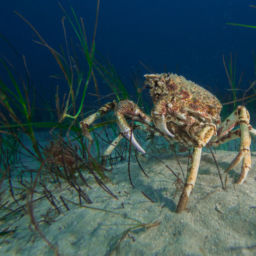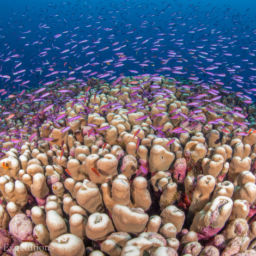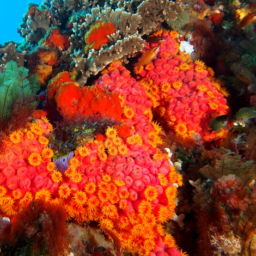With Australian borders reopened to tourism, now’s a great time to plan a trip Down Under. The Sunshine Coast has always been a popular Australian holiday destination. But was never really considered much of a diving destination until July 31, 2005. On that day there was a very large bang when an old warship was blown up. That ship, HMAS Brisbane, settled on the bottom in only three minutes. Today it is one of the most popular dive sites in Queensland.
Diving the HMAS Brisbane
In the few short years that the guided missile destroyer HMAS Brisbane has been on the sea floor it has been transformed from a stark, gray navy ship into a colorful artificial reef. Today the 436-foot (133 m) long ship pulsates with marine life and is an unforgettable dive.
Coloring the ship are soft corals, sponges, hard corals, gorgonians, ascidians and anemones. Hiding between these corals are nudibranchs, shrimp, crabs, crayfish, sea stars, flatworms, and lots of octopus.
Reef fish and pelagic fish cruise the decks of the ship, attracted to this oasis in a sea of sand. Divers commonly see batfish, sweetlips, angelfish, moray eels, fusiliers, snapper, kingfish, trevally, mulloway, lionfish, scorpionfish, basslets, pufferfish and rock cod. Several huge Queensland groupers occupy the ship, but generally hang out on the sand when divers visit. Also common are turtles, stingrays, eagle rays and large white-spotted wedgefish. The ship also has seasonal visitors like leopard sharks in summer and gray nurse sharks and humpback whales in winter.
However, it’s not just the marine life that makes HMAS Brisbane such a fascinating dive, but also the ship itself. The ship has dozens of cabins spread over four levels. And, with 30 access holes cut into the hull, there is virtually no part of the ship that can’t be safely explored. Features of the ship include its big, six-inch guns, the operations room, the engine room, the galley, and the crew quarters. HMAS Brisbane rests in 90 feet (28 m), with its deck at 50 feet (15 m). The funnels are at 12 feet (4 m), making this the perfect spot to end a dive on this incredible warship.
Other Sunshine Coast Dive Sites
The Sunshine Coast is located just north of the Queensland capital of Brisbane and directly south of the Great Barrier Reef. The area has beautiful beaches, numerous resorts and, in the hinterland behind the coast, rainforests, mountain retreats, and even a few wineries. Diving this area is done out of the town of Mooloolaba.
While HMAS Brisbane is easily the most famous dive site off the Sunshine Coast, the area also has other dive attractions. The best of these are three large subtropical reefs off Mooloolaba that are known as Inner Gneering Reef, Outer Gneering Reef, and Murphy’s Reef. These reefs vary in depth from 26 feet (8 m) to 110 feet (33 m) and offer exceptional diving on gutters, ledges, caves, and pinnacles. All are covered in such rich coral gardens that divers could easily think they were exploring the Great Barrier Reef. Reef fish and invertebrate species are abundant, especially nudibranchs, with the Sunshine Coast holding the record for the largest variety of species of these colorful sea slugs.
The deeper reefs generally have the more impressive marine life; which can include pelagic fish, stingrays, wobbegongs, turtles and gray nurse sharks over the winter months. There are dozens of dive sites on these reefs, including The Plateau, The Caves, Castle Rock, Wobby Rock, Hanging Rock and The Pinnacles.
Mudjimba Island
There are several other reefs in the area that divers don’t regularly visit, but one brilliant all-weather site is Mudjimba Island. This island doesn’t get the big fish, or the best visibility at times, but it does have lots of small reef fish and many other critters. The rocky reef that skirts the island varies in depth from 10 feet (3 m) to 60 feet (18 m), is decorated with pretty corals, and is home to a great collection of invertebrates. Commonly sights at Mudjimba Island are lionfish, sea stars, hermit crabs, cowries, mantis shrimp, boxfish, gobies, flatworms, boxer shrimps, cuttlefish, octopus, and countless nudibranchs. Mudjimba is also a great place to see turtles, with dozens using the site to feed and rest.
Shore diving is also possible at a number of sites in the area, such as Point Cartwright and Kings Beach. These sites have coral and reef fish that even snorkelers can see, but access to these sites is very weather dependent. The area also has a fabulous muck dive at La Balsa Park, in the Maroochy River. This easy shore dive is only 20 feet (6 m) deep, and the sandy rocky bottom is home to crabs, shrimps, pipefish, cardinalfish, flatworms, lionfish, octopus, pineapplefish, ghost pipefish, scorpionfish, and even the odd frogfish. However, the main feature is nudibranchs—thousands of nudibranchs.
With most of the dive sites close to shore, the visibility off Mooloolaba can be easily affected by wind, rain and swell. The visibility generally averages around 40 feet (12 m) offshore, and 20 feet (6 m) closer to shore but can vary from 10 feet (3 m) to 100 feet (30 m) and is always clearest after southerly winds.






























